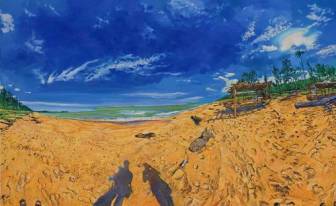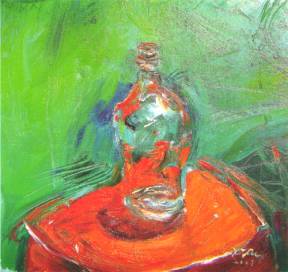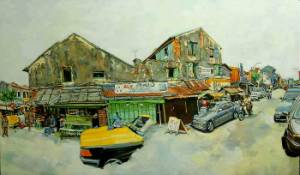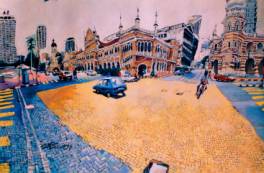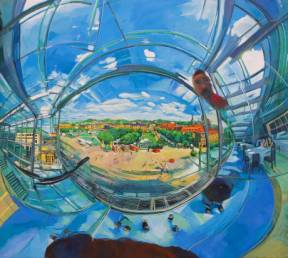Reality in Wonderland
In the Introduction chapter of Heinrich Wolfflin’s ‘Principles of Art History: The Problem of the Development of Style in Later Art,’ the author began with how 4 friends painted a similar landscape (same subject matter). They promised to remain true in the depiction of nature. At the end of the session, their productions reflected different results in accordance to individual character and personality. To artists and art historians, this observation is undoubtedly nothing new. Where everyone perceives and analyse things differently (*1).The question that comes to mind is, how do we comprehend and define our natural surroundings visually? Wolfflin further commented on the lesser interest of artists in style, stating that, “They take work exclusively from the standpoint of quality-is it good, is it self-sufficing, has nature found a vigorous and clear presentment…” (*2). This quotation brings our attention to the uniqueness of highly stylized and individualized depictions. No doubt, the essentials of nature or a subject matter is faithfully portrayed. However, more questions stem from the end result of picture making. How do our minds see and digest visual and optical information? Disconcerting effects cause us to reflect on ambiguity and notions of the real.
Prodding on the notions of the real, it is perhaps essential to read into Wang Zineng’s ‘Curatorial Notes’ for ‘Strategies Towards the Real: S. Sudjojono and Contemporary Indonesian Art.’ Wang posed these questions, “Is the real an objective realm that can be seen and understood similarly by everyone…Is the real as plain and apparent as the reality that surrounds us?”(*3). The real is further proposed by Wang to be conceptual in nature, when compared to reality (*4). In this instance, the proposition of the real in a configured setting fits the ideals and productions of Chin Kong Yee like a bullet to a gun. The artist’s time-based studies created interesting and whimsical memories. Hence, actual scenarios seemingly become the stage for fantasy constructed and derived from the real to showcase recollections of the past.
In departure from academic training of depicting accurately what we see in front of us, Kong Yee plunged into the artistic problems that arise from visual possibilities. There is a sense of continual transformation. The vision is juxtaposed in incongruous space, creating multiple layers in its evolvement from past, present to future. Chin Kong Yee presents depictions with different perspectives and experiences flowing through the paintings. Closer observation would perchance provide more acute and rhetorical readings of his intentions.
Perhaps Kong Yee’s artistic productions may also be seen from the viewpoint of pictorial representation. In ‘Art and Illusion: A Study in the Psychology of Pictorial Representation,’ Ernst Hans Gombrich questioned the representation of the visible world in different periods or ages. The author used exemplifications from psychology, philosophy to science in his construction of the answer to the above. Gombrich also brought our attention to the concept of schema. Meaning that the artist ‘‘begins not with his visual impression but with his idea or concept’’ and that the artist adjusts this idea to fit, as well as it can, the object, landscape, or person before him or her. Gombrich calls this theory ‘‘making and matching” (*5).To digress, Kong Yee obliged to share his working methodology with me in dialogue. He mentioned going to various places to capture the essence of the place. Kong Yee manipulates the images until he is satisfied before he works on the final art work. The artist has a preconceived idea of the desired effect and reconstructs existing images by kneading and wedging the idea to merge with the subject matter. Indeed, the concept of schema may define the stylistic tendencies of Kong Yee. It is interesting to note that the pictorial schema have also developed in ways that is different from the cult of the picturesque.
In 1768, William Gilpin published three essays on the Picturesque. The essays were entitled ‘Picturesque Beauty’, ‘Picturesque Travel’ and ‘Picturesque Landscape’. They served as guidelines to professional and amateur artists (*6). In addition, the essays provided directives as to how landscape compositions should be drawn, proposing clear definitions between the foreground, mid-ground and background. These were seen as important aspects required for the portrayal of inspiring compositional landscapes. The elements featured details, depth-of-view, nature and atmospheric conditions (*7). Kong Yee’s paintings are in a way, an infusion of schematics combined with elements of the picturesque to create a unique vision of his surroundings (Fig. 1).
In a feature of Kong Yee’s previous solo exhibition, Li-En Chong wrote that the artist was inspired by Surrealism and Abstract Cubism (*8). My dialogue session with the artist suggested Cezanne as an important influence. The latter’s usage of colour and fragmentation of objects to basic shapes, coupled with his indifference from portraying reality as it is resulted in a huge impact on Chin Kong Yee. Here, we may sense the attempts made by Kong Yee not to create a reproduction but to express and enforce the feelings felt from depicting the subject matter (Fig. 2). He did not want to emulate Cezanne. Kong Yee wanted to look beyond, developing his own ideals and concepts of time and vision.
Another feature written by Francis Dass provided interesting insight on street scenes. Dass wrote that, “If one really takes the time to observe closely, the streets are very telling of the cultural influence that surrounds and pervades them. Streets lines with kopitiams have a distinctly Chinatown feel, while those with Indian or Indian-Muslim shops have a uniquely quaint air about them just as city centres and their buildings have a distinctively cosmopolitan and urban feel to them (*9).(Fig. 3 and Fig. 4)
Reality in Wonderland sounds like a title for a Walt Disney cartoon, ala Alice in Wonderland. A paradox of living in the unreal or fantastical world we see in animation. Chin Kong Yee has made sense of this, by juxtaposing real situations within imaginative settings. The artist feels strongly for this, noting that in reality nothing is stagnant. Images change and evolve as we look at them. Years ago, the artist invented a painting style he coined Actuality Accorded Painting (AAP). The rendition of AAP may be read as the depiction of the real via non-stagnated images that change and evolve as we look at them. The unfixed image is thus the artist’s impression of different times and happenings of a place viewed collectively in a single instance. This time-based study of the artist produced images that titillate our senses. Recently, I asked him about AAP again, in a bid to extract deeper meanings for this technique. His response was to paint according to one’s feelings and intent, not to follow others. The painting will stand-out if it is done with honesty.
How did it all begin for Chin Kong Yee? What prompted him to create such idyllic and mind-bending images that we see today? For every artist, there is a starting point, a tiny step that set them on the yellow brick road in a bid to achieve their goals and objectives. Chin Kong Yee began his artistic practice in 1999. Swept up by the tornado that is the Asian financial crisis, he was inherently strong-willed and determined to succeed in his ambition. The financial instability and insecurity he felt prompted the need to look beyond the confines of stereoscopic vision. Kong Yee said, “How do we see in a wider scope in view of all the uncertainties we face?” Being aware of the focal issues in monocular visions, he sought for answers in the encompassing vision of living things like fish and dragonfly. He also voiced the human need for others to see in a wider spectrum, be it diagonally or vertically. His intention to expand our human view started the early paintings that would have been rejected decades ago. From Kuala Lumpur, Kong Yee created his own visual language, stretching our vision beyond the norm. He studied time, incorporating antiquarian and current elements in a historical dialogue. The title became a notation of the place, which is less significant to the point of inconsequence. Each painting was a narrative, filled with layering similar to Chinese paintings. Note the elongated Chinese format of certain paintings (left to right or right to left) (Fig. 3). The artist voiced his concern again stating that, “Everything is detailed and focused in the background. Good layering is a must of every painting. Then only do we have more things to see in the painting”. Figure became a very important aspect of his works. ‘Disjointed people’ enforced the fleeting moments and our impermanence in time.
An avid traveller, Kong Yee is never without his trusty camera, looking for interesting objects or compositions. Photography is important to the work. He takes every view and angle into consideration before embarking on finalizing his composition, with a penchant to look at the environment, people and local life. The artist gently reminds me that he did not use fish-eye lens for photo shooting. Furthermore, much of how he shot was determined by ideas he had at that point of time. According to Kong Yee, photographs presented real documentaries, while painting dealt with colour and form. Colour, especially, was crucial in its definition of time and space.
If we compare the earlier productions to the later ones, Kong Yee has developed and matured rapidly as an artist. In a decade of practice, viewers are taken on a ride to grow and learn from this prolific artist. Older works positioned the viewer at t-junctions compacted with details and perspective. From 1999 to 2003 much of Kong Yee’s attention was directed at buildings. From 2003, he arrived at crossroads in his practice. Being more at peace with himself compared to the turbulent years, his style also matured. Kong Yee began using a sphere to represent inner peace and calm at the center, protected against the storm raging at the periphery (Fig. 5). Until 2007, he was deeply ingrained in his use of the same colour range and confined himself to working within a specified space or frame. His recent works are poignant and suggestive. New works are more personal, featuring stairs and bridge(s) signifying a communicative discourse with his grandmother. The works are thus an outpouring of innate feelings and sensitivity in confluence with his experience of travelling abroad.
Kong Yee read a wide range of topics, including Chinese philosophy. The reason, he said was the need to know and to understand. He has also read extensively into Western and Eastern art history. I vividly remember his take on art history, “To be a contemporary artist, we need to know [art] history. Do not divide Eastern and Western Art. Collate all forms of history as reference for our work.” Kong Yee recognized the importance of history as a foundation for art practice. “In order to move forward we have to understand our history”, he added.
In the course of writing for Chin Kong Yee, one wonders at the surreal sensations experienced, falling deeper and deeper into his reality or is it wonderland?
Kelvin Chuah
Heinrich, Wolfflin. Principles of Art History: The Problem of the Development of Style in Later Art. M. D. Hottinger trans. United States: Dover Publications, Inc., 1950, p. 1
(*2) Ibid, p. 10
(*3) Wang, Zineng. ‘Curatiorial Notes’ Strategies Towards the Real: S. Sudjojono and Contemporary Indonesian Art. Singapore: NUS Museum, 2008, p. 7
(*4) Ibid
(*5) Art and Illusion” 17 June 2009
(*6) Ades, Dawn, ed. Art in Latin America: The Modern Era, 1820-1980. Cambridge, New Haven and London: Yale UP, 1989, p. 74-75.
(*7) Piyadasa, Redza. “The Cult of the Picturesque.” Business Times [Kuala Lumpur] 11 Jan. 1997: n.p.
(*8) Chong, Li-En. “The view from his crystal ball” The Star 6 June 2005, p. 19.
(*9) Dass, Francis. “Under the sheltering sky” New Straits Times. 27 June 2005, p. 12-13.

